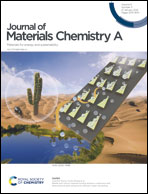Stacking design in photocatalysis: synergizing cocatalyst roles and anti-corrosion functions of metallic MoS2 and graphene for remarkable hydrogen evolution over CdS†
Abstract
CdS has been regarded as a promising visible-light-response photocatalyst in H2 production while its practical application is often limited by low photoactivity and serious photocorrosion. To tackle these problems, traditional CdS based core–shell and supported photocatalysts have been widely developed but they also suffer from intrinsic structural drawbacks. Herein, a novel stacked nanostructure with CdS embedded at interfaces between graphene supports and metallic MoS2 overlayers has been designed to eliminate the shortages and achieve outstanding photocatalytic performance, which reaches an optimum H2 production rate of 14.4 mmol gcat−1 h−1 and realizes an apparent quantum efficiency of 23.7% at 420 nm without obvious deterioration of activity in 20 h cyclic testing, far exceeding that of pure CdS by a factor of 17.9 times. The enhanced photocatalytic performance is mainly ascribed to the synergistic effects of MoS2 and graphene: (1) the intimate contact between the CdS core and MoS2 shell with a large interfacial area favors the transfer of photogenerated electrons to MoS2 cocatalysts, while a high-percentage 1T-phase provides an excellent electron mobility in the MoS2 cocatalysts and a high density of active sites for H2 evolution; (2) CdS cores are protected by MoS2 and graphene from photocorrosion, in which photogenerated holes are quickly transferred to the MoS2 shell and isolated from the sulfide surface, while excessive electrons in CdS are shuttled to adjacent MoS2 outer layers by graphene supports for H2 evolution in reducing their recombination with holes in the MoS2 shell and increasing the number of MoS2 sites available for the proton reduction reaction. The stacking design can be extended to the fabrication of other highly efficient photocatalytic systems.



 Please wait while we load your content...
Please wait while we load your content...